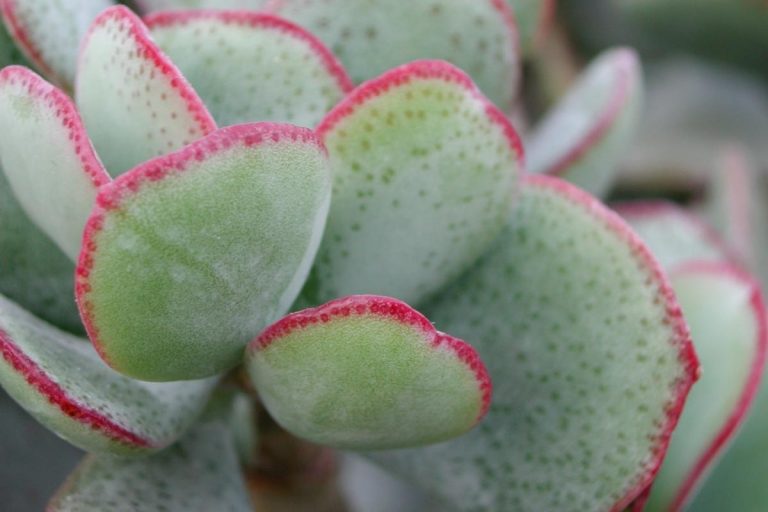Begonia Maculata Care: Best Essential Tips
If you’re thinking of getting a rare indoor plant that can serve as an eye-catcher for any person entering the room, the Begonia Maculata is the plant for the job.
This gorgeous-looking plant originates from Brazil and can be found growing naturally in the tropical Atlantic rainforest.
Begonia Maculata has a high reputation amongst plant lovers. Taking great care of this plant, in return, rewards you with beautiful white blooming flowers.

DISCLOSURE
Some of the links on here are affiliate links and I may earn if you click on them, AT NO EXTRA cost to you. Hope you find the information here useful! Thanks.
Related Articles:
- Scindapsus Treubii Moonlight: A Plant Lovers Care Guide
- Philodendron Hastatum: The Beginners Care Guide
- Anthurium Clarinervium: The Most Effective Care Guide
- The Best Practices to Care for Philodendron Birkin
- Pilea Glauca – The Ultimate Indoor Plant Guide
- Scindapsus Treubii Dark Form – Care Tips
What Are the Key Features of Polka Dot Begonia?
This Polka Dot Begonia is famous for its unique silver dots on its oblong, dark green leaves with a red underside.
The leaves have spots that are often mistaken for paint stains, which also strikes a shocking resemblance to a bat or an angel wing.
A healthy and happy Polka Dot Begonia can grow up to two feet tall with a leaf span measuring up to eight inches wide.
This Polka Dot Begonia also produces white petaled flowers with a yellow centre and commences its bloom from spring until the end of summer.
How Do You Care for Begonia Maculata?
Just like any other indoor plant, they’re most likely to have originated from the tropical rainforest. If you can duplicate and recreate its natural environment as close as possible, there shouldn’t be a reason for it to not thrive and achieve maximum growth potential.
It is crucial to pay attention to your plant’s basic requirements on water, light, soil, and temperature as this information will be the foundation to help you on your journey on taking care of this particular plant.
By following these care tips closely, rest assured you will have a healthy growing plant that can last a lifetime if that isn’t too far-fetched. Let’s get stuck in and let the Begonia Maculata care tips learning begin to commence.
What Are the Begonia Maculata Light Requirement?
Like with many other tropical houseplants, Begonia Maculata enjoys bright and indirect sunlight to grow strong and sturdy. If it lacks sufficient light, the stems tend to be weak and the leaves are noticeably lacking in vibrancy.
Place this gorgeous plant outdoors for some lumen vitamines keeping in mind to place it in a shaded area and not under direct sunlight during the summer.
And if your Polka Dot Maculata does get exposed to direct sunlight for too long, the leaves can get a bad sunburn and turn yellow. You need to remove those damaged leaves immediately to avoid pest infestation.
If you do happen to live in a region where the sun doesn’t shine abundantly and your plant is beginning to show signs of light deficiency, you may want to consider placing your plant under artificial fluorescent lights for 14 hours a day.
We recommend this LED Grow Light for Indoor Plant, is very affordable!
What Is the Best Soil for Begonia Maculata?
One of the most important Begonia Maculata Wightii care tips is to use the right soil type as the soil is going to be the medium to what feeds and provides nutrients to your plant.
As Begonia Maculata is most commonly prone to root rot, a fast-draining soil mix is the best option to avoid waterlogging.
Get this Miracle-Gro Indoor Potting Mix, save money and buy 2 for the price of one!
You can also prepare your soil mixture by mixing equal parts of potting mix, perlite, and orchid bark. Perlite and orchid bark will help to keep the soil airy and light.
It is also recommended to annually re-pot your plant with fresh soil to ensure a continuous supply of nutrients for your Begonia Maculata.
What Type Of Fertilizer Is Suitable for Begonia Maculata?
Begonia Maculata enjoys being nourished with fertilizer during its growing seasons of spring and summer. Fertilizer provides macronutrients including nitrogen, phosphorus, and potassium to your plant.
You can opt to use a well-balanced liquid fertilizer on alternate weeks between April and September if you want to have large healthy leaves with gorgeous flower blooms.
Another type of fertilizer such as a slow-release fertilizer can break down and release its nutrients into the soil in each watering cycle. This type of fertilizer will last you for about three months.
However, over-fertilizing may affect your Polka Dot Begonia growth rate and you can end up having burnt, dried, and wilting leaves.
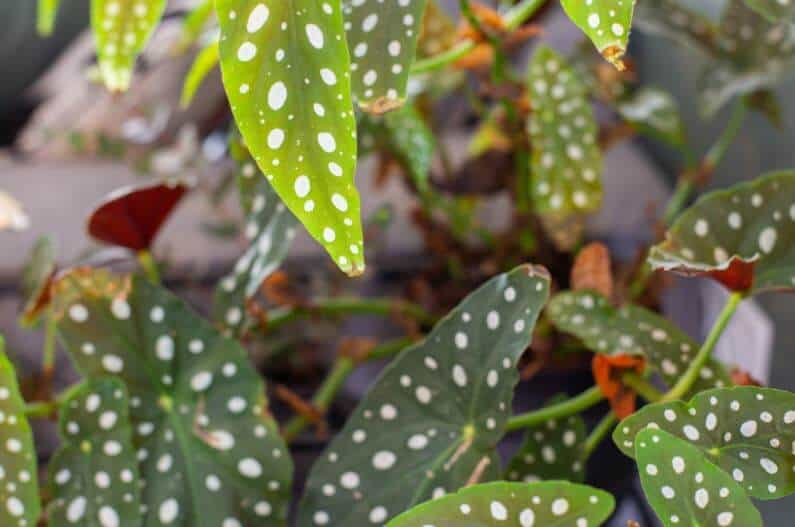
What Are Begonia Maculata Watering Requirement?
Polka Dot Begonia enjoys a weekly watering routine but as this plant is really susceptible to root rot, you will need to pay attention to the dampness of the soil before watering.
To check if your Begonia Maculata requires watering, use your finger to touch the first top inch portion of the soil for any dryness, and if so, you should consider watering it.
Your Begonia Maculata needs to be watered frequently, especially during the spring and summer season when it’s in its most active growing period.
During the winter season, providing your Begonia Maculata indoor care will slightly differ as your plant would require much less water as the growth rate begins to slow down. Consider using a moisture meter to check if your plant is overwatered and for a more precise reading.
This budget-friendly Soil Moisture Meter has all the functions you need!
What Temperatures Do Begonia Maculata Prefer?
The ideal temperature for your Polka Dot Maculata care is between 16C to 30C and since they are tropical plants, they are very sensitive to cool environments.
If you have placed your plants outdoors during the whole summer, don’t forget to move them indoors once the temperature begins to decrease below 15C to avoid frost damage.
During the winter, a sudden change in temperature will and can cause severe damage to your plant’s living tissues, therefore avoid shifting the plant around too much and place it in a warm and humid environment.
Do Polka Dot Begonia Enjoy Humidity?
Apart from having an ideal temperature, another important Polka Dot Begonia care tip is to have an environment with a high humidity level, as these plants are native to the tropical rainforests in Brazil.
The ideal humidity level for these plants is above 45%.
Therefore, place them in the kitchen or bathroom as these two locations typically have higher humidity levels than other spots in the house.
During winter, it may be a challenge to maintain the humidity level as the temperature turns cooler and surrounding air becomes drier.
You can increase the humidity level at home using a humidifier or you can simply just place your plant on top of a tray filled with pebbles and water.
This mini humidifier from the brand LEOP is a great option!
Does Begonia Maculata Attract Pests?
By following these Begonia Maculata plant care tips closely, we can do our best to prevent and avoid an infestation. However, keep in mind, having high humidity levels and overwatering can attract the following pests:
Tiny, moth-like insects feed on the plant sap causing your plant’s leaves to be yellow and disfigured.
Small, pale insects suck the plants’ sap which can cause stunted growth and ultimately your plants’ death if not treated fast.
Not an insect but closely related to the spider. This creature sucks on the plants’ sap causing your plant to have a faded look.
Although it may not happen very often, and if you do experience the above-mentioned pests attack, you can spray the Polka Dot Begonia with neem oil extract.
(Neem oil is an organic insecticide thus making it safe to use indoors for houseplants)
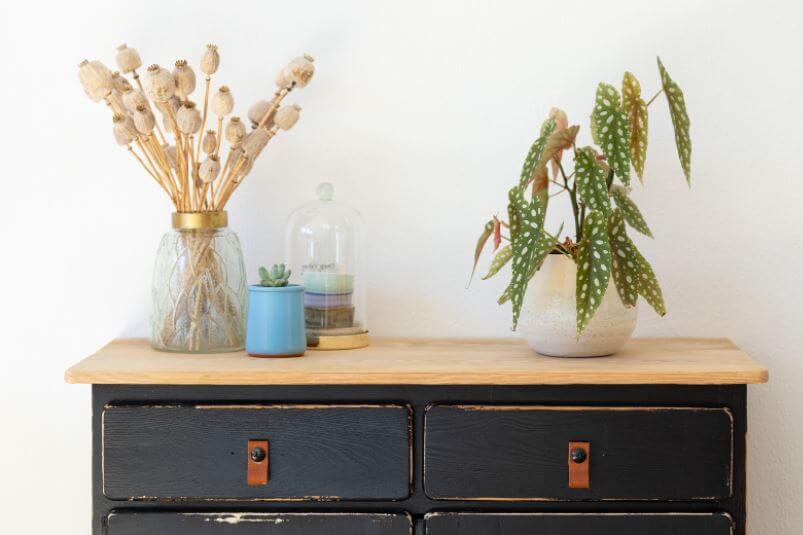
How Do I Get Begonia Maculata to Flower?
Begonia Maculata is a house plant that can flower indoors. It produces clusters of white, pink, and red petals from each flower stem.
These flowers usually bloom during the spring season and each flower has about five to seven petals with yellow cheery at the centre.
A key Spotted Begonia care tip on getting it to flower is to ensure the plant receives bright indirect sunlight at home.
Besides sufficient light, fertilizing Begonia Maculata also helps to increase flowering production during the spring season.
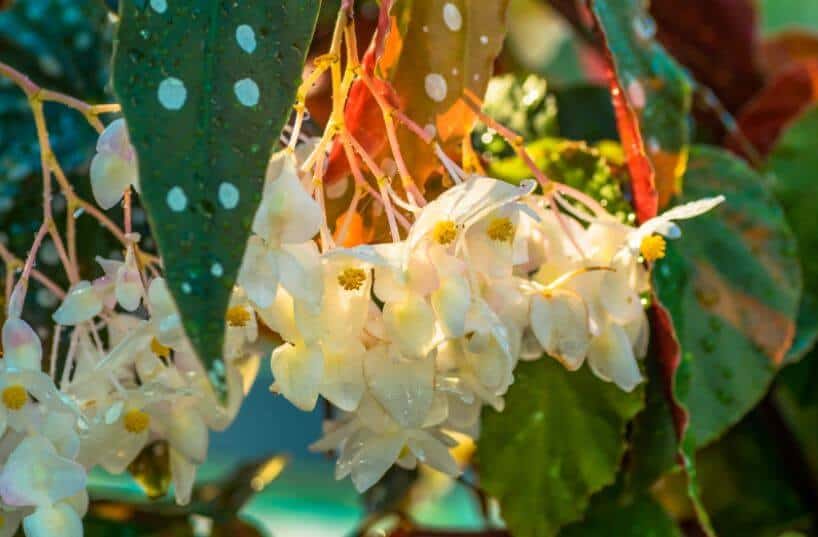
How Do You Prune Begonia Maculata?
Pruning Begonia Maculata is a vital step to encourage new stem growth by removing dry leaves and dead stems from the plant. Leaving dead stems can increase the chances of a pest infestation if not removed.
Regular pruning can also help improve airflow and light penetration to the plant leading to a healthier Begonia Maculata.
It is advisable to sterilize equipment using alcohol or household disinfectant before pruning your plant to avoid any fungal infection to the stems.
Pruning and repotting should not be carried out at the same time to avoid causing additional stress to the plant.
How Do You Propagate Begonia Maculata?
There are three ways to propagate Begonia Maculata;
- Seed
- Stem
- Leaf cuttings
Both stem and leaf cuttings are easier propagation methods compared to the seeding method.
Here is a detailed step-by-step on how to propagate Polka Dot Begonia using the stem cutting method in soil:
Step 1: Sterilize the utensils using alcohol or household disinfectant.
Step 2: Cut the tip about 3 to 4 inches long below a node with several leaves attached at the top.
Step 3: Place about two to three cuttings in a pot filled with a moist potting soil mixture.
Step 3: Cover it with a plastic bag to create a high level of humidity preferred by the plant. Place it under bright, indirect sunlight.
Step 4: Once rooting has begun, you can remove the plastic cover and proceed to water the plant moderately.
Step 5: When you notice the roots have reached about one inch long, remove each plant separately into a new pot and treat them as a mature plant.
When Do You Repot Begonia Maculata?
It is always a good idea to repot your plant regularly to keep them healthy and ensure a supply of fresh nutrients from a new batch of potting soil mixture.
If you notice the plants’ soil drying out more quickly than before and the leaves are turning brown, it is a sign that your Begonia Maculata needs to be repotted.
Once you have decided to re-pot, you can proceed to do so during early spring before the active growing season starts. Avoid repotting during winter when your plant is going through the dormancy stage.
When you re-pot Begonia Maculata, choose a pot one size larger than the current one so that the roots have space to grow further.
Begonia Maculata Toxic?
If you have pets at home, do take note that the Begonia Macula plant is considered toxic.
This plant should be kept away from pets, due to the presence of soluble calcium oxalate which may cause kidney failure, vomiting, and salivation if consumed.
If you notice your pets displaying symptoms such as redness around the mouth, swelling, choking, and excessive drooling. Contact your nearest veterinarian immediately to obtain the necessary treatment.
How To Deal With Transportation Stress?
It is common to purchase plants from online retailers and it is also easy for plants to experience transportation stress if they are not packed and transported appropriately.
When you receive your Begonia Maculata from the transporter, unpack it immediately and check the soil condition assessing if it is too dry and requires watering. If so, rehydrate the plant immediately.
Next is to create and place your plant in a humid environment, keeping it warm within an ideal temperature between 18C to 25C. You can also simply and quickly use a weather hygrometer to monitor the temperature and humidity level indoors.
This weather hygrometer has a modern style and a fair price! Your wallet will thank me.
Keep the plant under indirect sunlight for 3 to 7 days whilst ensuring the soil is kept moist and hydrated. Your newly arrived plant will probably take a few weeks to adjust to its new environment and it should be good to go.
Unique Tips For A Happy Begonia Maculata
- Overwatering will cause root rot, thus do ensure the top two inches of the soil are dry before watering.
- If the weather gets too cold, use a piece of cotton sheet to cover your plant to prevent frost damage.
- Place your plant at East facing windows to obtain the best sunlight.
- Avoid misting Begonia Maculata leaves as they are susceptible to powdery mildew if left untreated.
- When you notice the leaves are yellowing or wilting, it is an indication that your plant is dehydrated and needs watering soon as.
Conclusion
All in all, this isn’t really a difficult plant to look after, especially considering the much less amount of attention and care required compared to the other indoor varieties.
Ensuring you follow these Begonia Maculata plant care tips shared in this article, increases your chances of providing the best care needed and being truly rewarded by your plant providing you with blooming flowers.
Begonia Maculata or also commonly known as Polka Dot Begonia makes a wonderful gift for any plant lover. Flaunting its exotic peculiar polka dot leaves, places a presence in the room, putting a smile on everyone’s face.







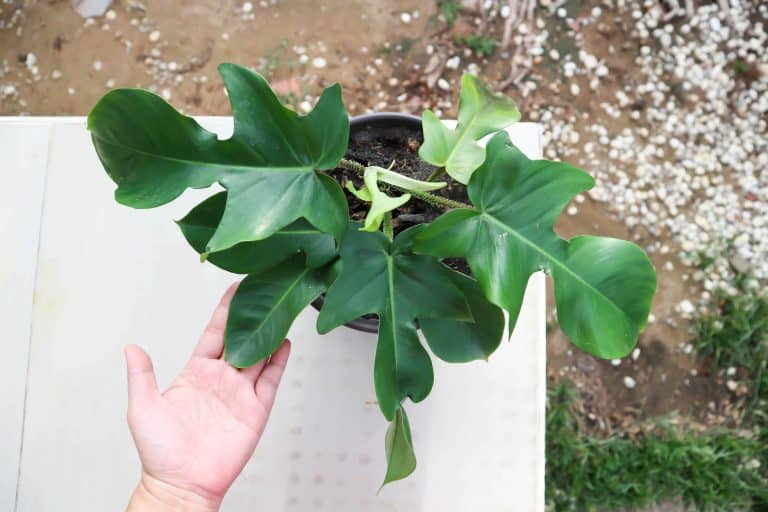
![Philodendron Brasil – Top 7 Simple Care Tips [2022 Guide]](https://aboveandbeyondgardening.com/wp-content/uploads/2022/02/Philodendron-Brasil-768x512.jpg)
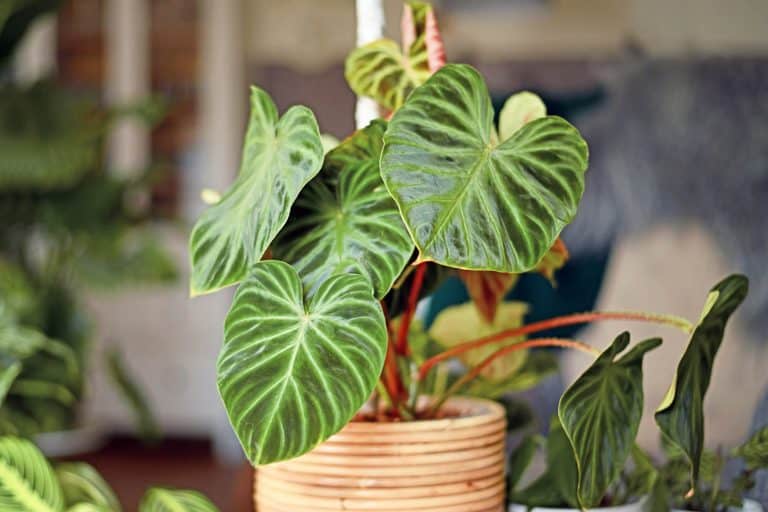
![How To Harvest Oregano Without Killing The Plant? [Personal Experience!]](https://aboveandbeyondgardening.com/wp-content/uploads/2022/10/How-To-Harvest-Oregano-Without-Killing-The-Plant-7-768x442.jpg)
![Tomato Plants Over Winter: How To Help Them THRIVE! [2023]](https://aboveandbeyondgardening.com/wp-content/uploads/2022/10/tomato-plants-over-winter-2-768x514.jpg)
